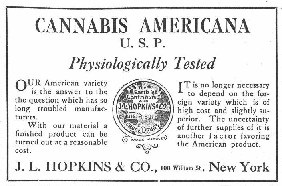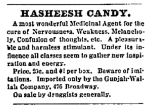ADVERTISEMENTS
FOR MEDICAL CANNABIS
Chapter 12

CANNABIS ADVERTISEMENTS:
During the First World War (for numerous reasons) Americans' easy access to imported botanical raw medicines was abruptly cut off. With its ability to import Cannabis Indica (Cannabis from Hindu-stan) abruptly curtailed, America was forced to turn to its domestically grown Cannabis Americana for its medical needs.
 World War I |
 Trade Cards |
 Post Cards |
 Match Book |
 Pre-Civil War |
 Piso's Almanac |
 Generic Ad's |
 General Ad's |
 Generic Ad's |
 Display Ad's |
12.0 - CANNABIS ADVERTISEMENTS: [See Pictures]
Remembering that before 1937, with extremely few exceptions, Medical Cannabis products were quite legal and available in almost any corner drug story. It thus should come as no suppose that they were also quite openly advertised.
However, to our knowledge, there are no active collectors for pre-1937 Cannabis medical ads. Perhaps it's the fact that medical ads in general are boring, or it could be a whole host of unknown reasons, but it appears that magazine advertisements for Cannabis medicines command no higher (but no lower) a price than any other medical ad from that era: And that's not much (between $8 to $20).
Their failure to sell for a premium (at least in the authors' opinion) seems to lay in the generality of the ads. (Note that this book has even been forced to place arrows on some of these ads just to indicate where Cannabis is mentioned). Also, in their total lack of creativity, which was true of all legitimate manufactures of their day. It seems that only Quack medicine ads, from that era, showed marketing expertise.
For those interested many old Cannabis ads can be found on the pages of many of the old pharmaceutical and medical magazines, back issues of which can still be obtained in most medical school libraries.
12.1.1 - GENERIC ADVERTISEMENTS: [See Pictures]
Ads like the ones shown on these pages (which were all too typical of their day), show the basic reason why Cannabis medical ads command such low prices in today's market. In general they are quite boring, command no imagination, and worse still, are so general in nature (Cannabis was seen back then as simply another medical ingredient) that one has to look hard just to find the word Cannabis.
Granted, given the Victorian times, a picture of naked women dancing around a may pole, would have been most inappropriate, but still there is no excuse for such boring ad's. Only the Quack medicine ads showed any creativity, and (see Chapter 15) unfortunately alcohol and opium were the mainstays of Quacks, not Cannabis.
12.1.2 - PROBLEMS WITH GENERIC AD'S: [See Pictures]
For students of history, pre-1937 Cannabis ad's generally suffered from two very major flaws.
First, seldom was Cannabis itself the central point of the ad. Even in Botanical Ad's Cannabis (like just about any other botanical drug) was simply one among many others. A factor that now is causing no end of consternation for historians and antique collectors alike. For example, notice the Mulford or the Eli Lilly ad's: Would the average reader have even noticed the mention of Cannabis were it not for the arrow [that we added]?
Second, while the pure food and drug act of 1906 required the products label to state whether-or-not Cannabis was an ingredient, it did not require paid ad's for the product to also do the same. Thus some manufacturers such as Battle & Co. (Bromidia) always did, most (as can be seen from various ad's) did not. Take for example the Kurokol (pronounced Cure-ah-cold) Ad. What would happen if one did not already know that Kurokol contained Cannabis? Would it even have been noticed?
12.2 - PRE-CIVIL WAR CANNABIS AD'S: [See Picture]
One feature that is quickly noticed by the average observer, and can be attested to by any historian, is that ALL pre-Civil War[1] ad's suffered from a lock of graphics. Yes, the printing technology was there, but not yet economically practical, at least not for the average advertiser----A factor that would plague advertisers well into the late 19th Century.
Just placing these old Cannabis ad's together in chronological order tells the story. At first only written words, than Large Type begins to appear, followed in later years by simple arrows or block characters. Only into the 1880's do actual (but simple) graphics begin to appear.
Thus, the main factor the separates post from pre-Civil War ads is the reliance on kind and type of wording.
12.3 - WORLD WAR I: [See Picture]
During the First World War (for numerous reasons) Americans' easy access to imported botanical raw medicines was abruptly cut off. With its ability to import Cannabis Indica (Cannabis from Hindu-stan) abruptly curtailed, America was forced to turn to its domestically grown Cannabis Americana for its medical needs.
It should be remembered that at the time there was a general perception that Cannabis Indica was superior in quality to Cannabis Americana. Victory ads like the one above were made to reassure the public (as well as potential buyers) that their local "Home Grown Cannabis Americana" was every bit the equal of the previously imported Cannabis Indica.
12.4 - OTHER TYPES OF ADVERTISEMENTS:
Besides magazine ads, pharmaceutical companies used various other means, such as post cards, give away pamphlets etc., to advertise their products. Some of them have some collectability in today's market.
12.4.1 -- TRADE CARDS: [See Picture]
Before the creation of the business card, there were trade cards, (think of them as a cross between a modern day business card and an advertising leaflet). Merchants and sales personnel would give them out to prospective clients or in general use them in the same way that we would use business cards in today's business environment. The one shown below is from the McNeil's Medicine Co.
Above - a 19th century trade card (front and back) which or may not have belonged to the McNeil Co. (manufacture of Cannabis products) and is now a part of Johnson and Johnson. Its value is only about $5.00. While there are collectors for trade cards, no trade cards themselves have been found that display Cannabis ads.
Even those trade cards that come from companies that manufactured Cannabis products seem to carry no extra value.
12.4.2 - MATCH BOOKS & POST CARDS: [See Pictures]
Perhaps the Piso's Co. (quack medicine company or not) offers the best examples of post cards being used for advertising purposes. Unfortunately, because of their generic nature, they command low prices on the market today, only between $5 and $25 dollars each.
12.4.3 -- GIVEAWAY ALMANACS: [See Picture]
Once more Piso's Co. provides an excellent example of promotional giveaways, which are now being much sought after by the antique collectors.
Originally named the Hazeltine Co., later on changed to The Piso Co., for many years (1879 to 1917) it published a series of small (less than 3" square) but colorful almanacs, which it cleverly gave away though pharmacies that sold its products. If a pharmacist wanted to obtain and give away these booklets, it would have to sell its products.
In addition to the almanacs other booklets were published by the company with such titles such as "A Plucky Woman" etc, in which (somehow or another) Piso's Cure would always save the day.
This almanac is presented here solely as an example; numerous other companies also put out pamphlets and almanacs.
For the most part they were put out by patent medicine Mfg. (which usually did not make reference to their ingredients) and as such is outside the domain of this book. Today antique collectors are willing to pay between $10 and $35 (depending upon condition) for each.
15.5 -- STORE LOBBY DISPLAY AD'S: [See Picture]
Although hard to find, drugstore Lobby-cards as well as Cardboard Displays ad's are much sought after by medical antique collectors today.
Note however (as with all other advertisements), that while the pure food and drug act of 1906 required the products label to indicate whether-or-not Cannabis was an ingredient, it did not require the products advertisements to also do so. Thus, just from the Mosco Display above it is all but impossible to determine whether or not Cannabis was actually used by the Callous remover. However, judging from the prices [very high for a pre-1937 ad], it must be assumed that it did not.
[1] With reference to the American Civil War [1860-1865].
 Back to the Last Chapter |
 BACK TO MAIN INDEX PAGE |
 On to the Next Chapter |